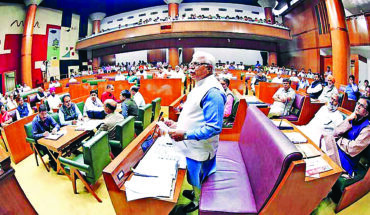
By Sri Krishna Kumar
Indus Water Treaty (IWT) between India and Pakistan is internationally regarded as an example of successful conflict resolution and one of the most durable water sharing agreements in the world, especially when it is between two nations almost perpetually in a state of hostility with each other. The Treaty was brokered by World Bank (then the International Bank for Reconstruction and Development) and signed in Karachi on September 19, 1960 by Pandit Jawahar Lal Nehru, Prime Minister of India and Field Marshal Ayub Khan, President of Pakistan. For 64 years both India and Pakistan are peacefully sharing the waters of Indus and its tributaries.
INDUS RIVER
Indus River originates near the Mansarovar Lake in Tibet on the northern slopes of the holy Kailash Mountain. It enters India through the Ladakh District of Jammu and Kashmir. The river runs to the northwest via Baltistan into Gilgit, immediately south to the Karakoram Mountain range, slowly turns southwards and enters into Pakistan where it flows the whole span of that country to join the Arabian Sea near Karachi. Indus River is 3,180 kilometers long and has a catchment basin of more than 1,165,000 sq. km. Approximate yearly discharge of the river is 207 cubic kilometers, making it the 21st biggest river in the world in terms of yearly discharge.
Indus River has five tributaries joining it from the east which together form the gamut of Indus Water Treaty. They are – from east to west – Sutlej, Beas, Ravi, Chenab and Jhelum. Of them, Sutlej originates from Rakshas Tal near Mansarovar Lake in Tibet; Beas, Ravi and Chenab originate in Himachal Pradesh and Jhelum has its origin at Verinag in the state of Jammu and Kashmir. All these five rivers have given its name to Punjab and they join each other to form a mighty Panjnad river before it outfalls into Indus River near Bahawalpur in Pakistan.
THE TREATY
According to the Treaty, “eastern” rivers Sutlej, Beas and Ravi are to be governed by India and the “western” rivers Chenab, Jhelum and Indus are taken care of by Pakistan. Further, India is allowed to draw 3.6 million acre feet of water from the three western rivers flowing into Pakistan, for non- consumptive use, agriculture and specified hydro-electric projects, which it has never utilized because of inadequate storage capacity. The Treaty creates the Permanent Indus Commission with a commissioner appointed by each country. It would follow the set procedure for adjudicating any future disputes arising over allocation of waters. Either party must notify the other of plans to construct any engineering works which would affect the other party and to provide data about such works. In case of disagreement, a neutral expert is called for mediation and arbitration. Though Indus and Sutlej originate from Tibet, China has been kept out of the Treaty.
LEVERAGE POTENTIAL OF INDUS WATER TREATY
It is not that IWT has never been considered by India as leverage against Pakistan during our 75 years’ old history of four full-fledged wars and innumerable skirmishes. Yes it was, but every time the idea had to be abandoned due to insurmountable constraints. It is again making headlines with jingoistic statements like “water is the only tool of leverage India has over Pakistan, and India should use it.” True, water is an extremely sensitive issue in Pakistan. They are a one-river nation. If Indus is stopped – or even partially starved – the consequences would be catastrophic for that agriculture-dependent country. On the other hand, India is well within its right to review the 56 year old IWT, which is causing consternation in Pakistan. But there is no question of revoking the Treaty, whatever the hawks within or outside the government may say, because it could harm India’s stature as a responsible nation upon which we are trying to build global consensus to isolate Pakistan. What the government should contemplate are the ways to fully utilize its award of waters – within the ambit of IWT – and thereby hold out a real threat of reduced water flow into Pakistan.
WHAT INDIA SHOULD DO
Any measures for reducing flow of water into Pakistan should not be initiated without carefully examining the consequences. We must go ahead with “permissible” utilization of waters from three western rivers for irrigation and hydro-electric power. But even if we ignore the paranoia of our neighbor who has repeatedly challenged even the “run of the river” projects allowed by the IWT and built by India – decision of Permanent Court of Arbitration at Hague in January 2014 in favour of our Kishenganga Hydroelectric power project being the latest such example – we will have to ponder over two critical aspects. First, the status of our capacity building – present and in near future – to utilize gainfully our rightful share of “western rivers” and second, our simultaneous diplomatic initiative to segregate the interest of the people of Pakistan – for whom any reduction in water supply could prove disastrous – from that of the jihadist elements both inside and outside the Pakistan government.
India will have to create massive storage facilities to utilize its share of the Indus River. Just to have an idea of the magnitude of the problem, our largest reservoir – the Indirasagar on Narmada has the capacity of storing 9.8 lakh acre feet while our share from three western tributaries of Indus is more than its three times, at 3.6 million acre feet. Developing capacities to store and regulate river flows of this immensity needs years to build, massive rehabilitation of population and huge funding. Still if we embark upon “dam building tool” to punish Pakistan, the consequences might be hugely detrimental to India. In experts’ opinion, barring water-scarcity during the winter harvest, it would be suicidal for India to block the natural flow of the rivers into Pakistan. Because, without the requisite infrastructure we would end up flooding our own hinterland.
THE WAY FORWARD
Big storages thus ruled out, the government should focus instead on short term doable measures.For example expediting the Tulbul Navigation Project – called Wullar Barrage by Pakistan – which is on hold despite the decision to restart it was taken in 2009. It aims at raising water levels in Jhelum River to allow round the year navigation between Srinagar, Anantnag and Baramulla. More navigation canals should be built as inland waterways to open up areas for better marketing of their produce. Other measures to reclaim part of our share – thereby reducing the flow into Pakistan –should be regulating riverine flows in Kashmir for developing better irrigation, recreation, sanitation and ecological facilities to boost its biggest industry which is tourism. Beautiful lakes of Kashmir valley including the Dal Lake – the biggest tourist attraction – have become polluted and are stinking. Available surplus water must be diverted for cleaning of lakes and draining out their filth, on a regular basis for healthier environment. Barrages or weirs could be suitably located for diversion schemes for irrigating exotic crops like saffron and tulips thereby increasing productivity. And finally many more hydro-power stations should be built to provide clean energy and make Jammu and Kashmir energy surplus state like Uttarakhand with a similar topography.
It is a paradox that Kashmiris have suffered the worst damage in the Indus Water Treaty between two nations each of which swears the interest of Kashmir as dearest to their hearts. By signing this Treaty, Pakistan has clearly kept its own interests supreme, almost abandoning those of Kashmir. While hammering this point over the local people, India should prioritize utilization of its due share of water in Kashmir to the maximum possible extent, so as to improve the living standard of Kashmiri people. This will initiate the biggest confidence building measure for the alienated people of this sensitive state.
Indus Water Treaty constitutes undoubtedly a big leverage for India, but not the way it is being viewed in the present surcharged atmosphere. We need not (and cannot) stop water flowing into Pakistan and earn bad name as irresponsible nation – in addition to running risk of drowning ourselves. This leverage should be used for the people of Kashmir by utilizing our due share of water for their uplift and prosperity. This will hurt Pakistan much more than just by having reduced flow of Indus waters. They will squirm also by the prospect of Kashmiri people once again reposing confidence in India, as they did explicitly after the failed invasion on Kashmir by Pakistan back in 1948.
*It is a white paper offering in-depth understanding of the Indus Water Treaty and its dimensions. The author is an internationally acclaimed expert on water issues. He was affiliated with various UN organizations, Government of India and has also served as the Chief Engineer in the Irrigation Department of the undivided UP, when it also comprised Uttarakhand.






